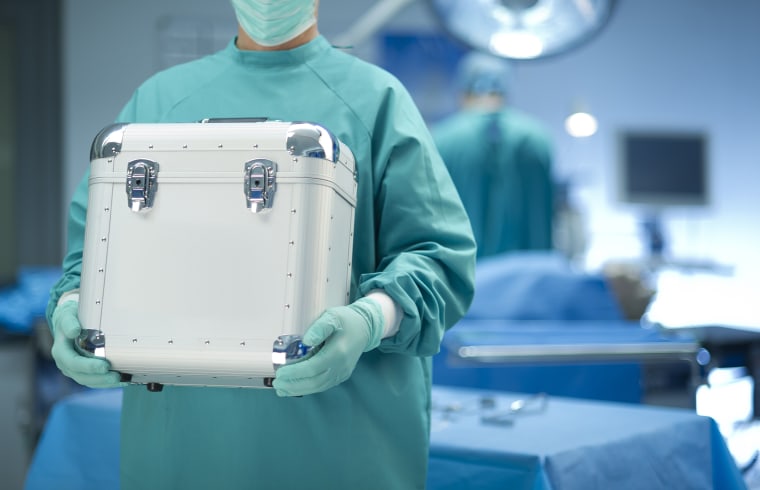Taylor Castro, a 25-year-old mother of three from San Antonio, was recovering from a brutal round of chemotherapy for acute myeloid leukemia, awaiting a stem cell transplant. But first, she needed a matching donor, ideally from a fellow Latino.
“If I don’t get the transplant, my body’s going to reject the chemotherapy,” she said in March, adding that she was first diagnosed with cancer about six months ago. “Being a donor is very important. You really can save somebody’s life.”
Castro died April 28, awaiting such a donor.
From marrow and organ donations to clinical trials, low Latino participation rates can have a devastating impact on cancer patients and negatively impact the long-term health and longevity of Hispanics, the nation's largest minority group and 18 percent of the U.S. population.
Ethnicity matters when it comes to marrow and organ donations and enrollment in clinical trials, according to Gift Matemba-Mutasa, director of marketing for Be the Match, a national marrow donor program.
The best outcomes take place when there’s a human leukocyte antigen (HLA) match between a donor and a patient. Patients of similar ethnic backgrounds or ancestry are more likely to match, and a closer match increases transplant success rates, helps donor cells grow and reduces complication risks, according to Matemba-Mutasa.
Of the 20 million people registered for Be the Match, only 7 percent are Latinos, he said.
Meanwhile, Hispanic Americans comprised less than 14 percent of organ donors in 2015, according to the most recent figures available.
Reasons for low Latino participation in bone marrow donations include a lack of awareness about the issue, as well as distrust and misperceptions about the process, costs and pain involved, he said.
There are strategies, however, that can help combat low enrollment, including bilingual community health providers and Spanish-language information, clear explanations about cost (the patient’s insurance and Be the Match covers it all) and information about pain. A donation involves a cheek swab, perhaps a plasma donation via IV and marrow donation under anesthesia.
After eliminating matches from family, cure rates for blood cancer are 77 percent for Caucasians, 46 percent for Latinos, 41 percent for Asians and 23 percent for African Americans. This points to the need for more Latino donors as the U.S. Hispanic population continues to grow.
A lack of Latinos in clinical trials
The struggle to draw Latinos to clinical trials is similar to that of marrow and organ donations, according to Maria P. Aranda, associate professor of social work and gerontology and executive director of the Edward R. Roybal Institute on Aging at the University of Southern California.
Latinos comprise only 1 percent of clinical trial participants.
Aranda says what may prevent many Latinos from enrolling in clinical trials is a low level of health literacy about certain disorders, a lack of information about clinical trials, not enough bilingual health providers and materials, and fear of being treated as “guinea pigs.”
Clinical trials are important because they test health and medical interventions, treatments and services, ideally on groups that are representative of the population as a whole. If a subgroup such as Latinos is omitted from a clinical trial, Aranda said, “you have to ask yourself, does that medicine that goes to market, or device or practice that is adopted, have the same effect on Latinos?”
Ideally, the number of Latinos participating in clinical trials would reflect the U.S. population. An exception, Aranda says, might be clinical trials for diseases such as Alzheimer’s, where Latinos are one and a half times more likely to develop the disease than non-Hispanic whites. Other diseases striking Latinos at higher rates include heart disease and diabetes.
One organization that has made strides in informing Latinos about clinical trials is the National Alliance for Hispanic Health. It serves a network of members, including community-based organizations serving Hispanics that provide health and other services to more than 15 million people annually, according to Adolph P. Falcón, the group’s executive vice president.
Since last year, when the National Institutes of Health launched a national research effort called All of Us, the alliance has been working to provide information to Latinos about the program, a historic effort to gather data from one million or more people living in the U.S.
“People are interested in this program because they want to make sure that the future is better for their kids," Falcón said.
“They may have had a parent with Alzheimer’s, a father who died of a heart attack or stroke, or maybe have a family member who has diabetes," he said. "They want their health to be better for their families.”
This article was written with the support of a journalism fellowship from the Gerontological Society of America, Journalists Network on Generations and the John A. Hartford Foundation.
FOLLOW NBC LATINO ON FACEBOOK, TWITTER AND INSTAGRAM.
